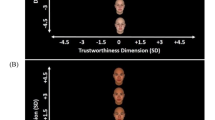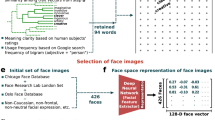Abstract
The notion of the ‘face effect’ in political communication denotes a process by which people spontaneously infer the personal character traits of political candidates (e.g., competence, attractiveness) from campaign portrait photographs and election posters. Previous research has shown that those spontaneous trait inferences (STIs) affect people’s voting decisions. Combining survey responses, election results from official statistics, and aggregate data, the present study demonstrates that STIs of competence, attractiveness, and leadership help to predict the outcome of direct election in Germany. Furthermore, results suggest that even when controlled for context variables, judgments about a candidate’s competence solely derived from his or her face are connected to the difference in vote shares between the winning candidate and the runner-up. Effects are particularly strong when newcomers compete against each other.
Similar content being viewed by others
References
Adam, S., and M. Maier. 2010. ‘Personalization of politics: a critical review and agenda for research’. Communication Yearbook 2010 34: 213–257.
Alley, T.R. (ed.). 1988. Social and Applied Aspects of Perceiving Faces. Hillsdale, N.J: Lawrence Erlbaum Associates.
American Association for Public Opinion Research. 2015. Standard Definitions: Final Dispositions of Case Codes and Outcome Rates For Surveys. 8th Edition, AAPOR.
Anderson, C.J., and F. Brettschneider. 2003. The likable winner versus the competent loser: candidate images and the German election of 2002. German Politics & Society 21 (1): 95–118.
Ballew, C.C., and A. Todorov. 2007. Predicting political elections from rapid and unreflective face judgments. Proceedings of the National Academy of Sciences 104 (46): 17948–17953.
Balmas, M., and T. Sheafer. 2013. Leaders first, countries after: mediated political personalization in the international Arena. Journal of Communication 63 (3): 454–475.
Barrett, A.W., and L.W. Barrington. 2005. Is a picture worth a thousand words? newspaper photographs and voter evaluations of political candidates. The International Journal of Press/Politics 10 (4): 98–113.
Bartels, L.M. 2002. The impact of candidate traits in American presidential elections. In Leaders’ Personalities and the Outcomes of Democratic Elections, ed. A. King, 44–69. New York: Oxford University Press.
Baum, M.A. 2005. Talking the vote: why presidential candidates hit the talk show circuit. American Journal of Political Science 49 (2): 213–234.
Bishin, B.G., D. Stevens, and C. Wilson. 2006. Character counts? Honesty and fairness in election 2000. Public Opinion Quarterly 70 (2): 235–248.
Brusattin, L. 2012. Candidate visual appearance as a shortcut for both sophisticated and unsophisticated voters: evidence from a Spanish online study. International Journal of Public Opinion Research 24 (1): 1–20.
Bucy, E.P., and J.E. Newhagen. 1999. The micro- and macrodrama of politics on television: effects of media format on candidate evaluations. Journal of Broadcasting & Electronic Media 43 (2): 193–210.
Cortina, J.M. 1993. Interaction, nonlinearity, and multicollinearity: implications for multiple regression. Journal of Management 19 (4): 915–922.
Dalton, R.J. 2000. The decline of party identification. In Parties Without Partisans : Political Change in Advanced Industrial Democracies, ed. R.J. Dalton, and M.P. Wattenberg, 19–36. Oxford: Oxford University Press.
Ekman, P., and W.V. Friesen. 2003. Unmasking the Face: A Guide to Recognizing Emotions from Facial Expressions. Cambridge, MA: Malor Books.
Esser, F., and B. Pfetsch. 2004. Comparing Political Communication: Theories, Cases, and Challenges, Cambridge, UK. New York: Cambridge University Press.
Field, A.P. 2013. Discovering Statistics Using IBM SPSS Statistics: And Sex and Drugs and Rock “n” Roll, 4th ed. Los Angeles: Sage.
Freier, R. 2015. ‘The mayor’s advantage. Causal evidence on incumbency effects in German mayoral elections’. European Journal of Political Economy 40: 16–30.
Freier, R., and S. Thomasius. 2016. Voters prefer more qualified mayors, but does it matter for public finances? Evidence for Germany. International Tax and Public Finance 23 (5): 875–910. doi:10.1007/s10797-015-9382-z.
Hayes, D. 2005. Candidate qualities through a Partisan lens: a theory of trait ownership. American Journal of Political Science 49 (4): 908–923.
Hayes, D. 2009. Has television personalized voting behavior? Political Behavior 31 (2): 231–260.
Hellweg, S.A., G.N. Dionisopoulos, and D.B. Kugler. 1989. Political candidate image: a state-of-the-art review. In Progress in Communication Sciences, vol. 9, ed. B. Dervin, and M.J. Voigt, 43–78. Norwood, NJ: Ablex.
Hopmann, D.N., C.H. de Vreese, and E. Albæk. 2011. Incumbency bonus in election news coverage explained: the logics of political power and the media market. Journal of Communication 61 (2): 264–282.
Kaase, M. 1994. Is There personalization in politics? Candidates and Voting behavior in Germany. International Political Science Review 15 (3): 211–230.
Karvonen, L. 2010. The Personalization of Politics: A Study of Parliamentary Democracies. Colchester, UK: ECPR Press.
Klein, M., and U. Rosar. 2005. ‘Physische Attraktivität und Wahlerfolg. Eine empirische Analyse am Beispiel der Wahlkreiskandidaten bei der Bundestagswahl 2002‘[Physical attractiveness and election success. an empirical analysis using the example of candidates of electoral districts in the federal elections 2002]. Politische Vierteljahresschrift 46 (2): 263–287.
Kriesi, H. 2012. Personalization of national election campaigns. Party Politics 18 (6): 825–844.
Laustsen, L. 2014. Decomposing the relationship between candidates. Facial Appearance and Electoral Success’, Political Behavior 36 (4): 777–791.
Levitt, S.D., and C.D. Wolfram. 1997. Decomposing the sources of incumbency advantage in the U. S. house. Legislative Studies Quarterly 22 (1): 45–60.
Lin, F.-J. 2008. Solving multicollinearity in the process of fitting regression model using the nested estimate procedure. Quality & Quantity 42 (3): 417–426.
Marcinkowski, F., and Metag, J. (2014) The effect of politicians’ facial appearance on voting behavior. Paper presented at the International Communication Association (ICA) annual conference; 23 May. Seattle, USA.
Mattes, K., M. Spezio, H. Kim, A. Todorov, R. Adolphs, and R.M. Alvarez. 2010. Predicting election outcomes from positive and negative trait assessments of candidate images. Political Psychology 31 (1): 41–58.
McAllister, I. 2007. The personalization of politics. In The Oxford Handbook of Political Behavior, ed. R. Dalton, and H.-D. Klingemann, 571–588. New York: Oxford University Press.
Mechtel, M. 2014. It’s the occupation, stupid! Explaining candidates’ success in low-information elections. European Journal of Political Economy 33: 53–70. doi:10.1016/j.ejpoleco.2013.11.008.
Miller, A.H., M.P. Wattenberg, and O. Malanchuk. 1986. Schematic assessments of presidential candidates. American Political Science Review 80 (2): 521–540.
Olivola, C.Y., A.B. Sussman, K. Tsetsos, O.E. Kang, and A. Todorov. 2012. Republicans prefer republican-looking leaders political facial stereotypes predict candidate electoral success among right-leaning voters. Social Psychological and Personality Science 3 (5): 605–613.
Patzer, G.L. 1985. The Physical Attractiveness Phenomena. New York: Plenum Press.
Pomante, M.J., and S. Schraufnagel. 2015. Candidate Age and Youth Voter Turnout. American Politics Research. 43 (3): 479–503.
Reid, L.N., and P.L.C. Soley. 1983. promotional spending effects in high involvement elections: an examination of the voter involvement explanation. Journal of Advertising 12 (2): 43–50.
Reinemann, C., and J. Wilke. 2007. It’s the debates, stupid! how the introduction of televised debates changed the Portrayal of chancellor candidates in the German press, 1949–2005. The International Journal of Press/Politics 12 (4): 92–111.
Rosar, U. 2009. ‘Fabulous Front-Runners. Eine empirische Untersuchung zur Bedeutung der physischen Attraktivität von Spitzenkandidaten für den Wahlerfolg ihrer Parteien‘[Fabulous front-runners. An empirical analysis regarding the importance of physical attractiveness of front-runner candidates for the election success of their parties.]. Politische Vierteljahresschrift 50 (4): 754–773.
Rosar, U., M. Klein, and T. Beckers. 2008. The frog pond beauty contest: Physical attractiveness and electoral success of the constituency candidates at the North Rhine-Westphalia state election of 2005. European Journal of Political Research 47 (1): 64–79.
Rosar, U., M. Klein, and T. Beckers. 2012. Magic mayors: predicting electoral success from candidates. Physical Attractiveness under the Conditions of a Presidential Electoral System’, German Politics 21 (4): 372–391.
Schoen, H. 2011. Merely a referendum on chancellor merkel? parties, issues and candidates in the 2009 German federal election. German Politics 20 (1): 92–106.
Söderlund, P. 2008. Retrospective voting and electoral volatility: a nordic perspective. Scandinavian Political Studies 31 (2): 217–240.
Sussman, A.B., K. Petkova, and A. Todorov. 2013. Competence ratings in US predict presidential election outcomes in Bulgaria. Journal of Experimental Social Psychology 49 (4): 771–775.
Swinyard, W.R., and K.A. Coney. 1978. Promotional effects on a high-versus low-involvement electorate. Journal of Consumer Research 5 (1): 41–48.
Todorov, A., A.N. Mandisodza, A. Goren, and C.C. Hall. 2005. Inferences of competence from faces predict election outcomes. Science 308 (5728): 1623–1626.
Todorov, A., M. Pakrashi, and N.N. Oosterhof. 2009. Evaluating faces on trustworthiness after minimal time exposure. Social Cognition 27 (6): 813–833.
Todorov, A., C.P. Said, A.D. Engell, and N.N. Oosterhof. 2008. Understanding evaluation of faces on social dimensions. Trends in Cognitive Sciences 12 (12): 455–460.
Todorov, A., and J.S. Uleman. 2002. Spontaneous trait inferences are bound to actors’ faces: evidence from a false recognition paradigm. Journal of Personality and Social Psychology 83 (5): 1051–1065.
Todorov, A., and J.S. Uleman. 2003. The efficiency of binding spontaneous trait inferences to actors’ faces. Journal of Experimental Social Psychology 39 (6): 549–562.
Todorov, A., and J.S. Uleman. 2004. The person reference process in spontaneous trait inferences. Journal of Personality and Social Psychology 87 (4): 482–493.
Tsfati, Y., D.M. Elfassi, and I. Waismel-Manor. 2010. Exploring the association between Israeli legislators. Physical Attractiveness and Their Television News Coverage’, The International Journal of Press/Politics 15 (2): 175–192.
Van Aelst, P., T. Sheafer, and J. Stanyer. 2012. The personalization of mediated political communication: a review of concepts, operationalizations and key findings. Journalism 13 (2): 203–220.
Van Aelst, P., and K. van Mierlo. 2003. ‘Politiek Als One-Man-Show? Over de Rol van Kranten in de Personalisering van de Politiek’ [Politics as a one-man-show. on the role of newspapers in the personalization of politics]. Res Publica 4: 579–602.
Wänke, M., J. Samochowiec, and J. Landwehr. 2013. Facial politics: Political judgment based on looks. In Social Thinking and Interpersonal Behavior, ed. J.P. Forgas, K. Fiedler, and C. Sedikides, 143–159. New York: Psychology Press.
Willis, J., and A. Todorov. 2006. First impressions: making up your mind after a 100-Ms exposure to a fce. Psychological Science 17 (7): 592–598.
Author information
Authors and Affiliations
Corresponding author
Rights and permissions
About this article
Cite this article
Marcinkowski, F., Lünich, M. & Starke, C. Spontaneous trait inferences from candidates’ faces: the impact of the face effect on election outcomes in Germany. Acta Polit 53, 231–247 (2018). https://doi.org/10.1057/s41269-017-0048-y
Published:
Issue Date:
DOI: https://doi.org/10.1057/s41269-017-0048-y




